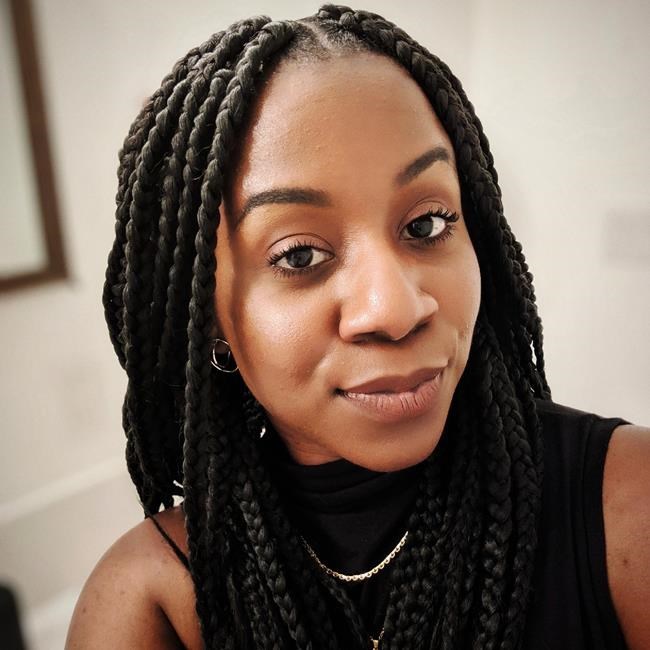Emerging evidence of violent police encounters shows some police tactics are "so egregious" that they're doing more harm than any possible good, says a Canadian activist.
Sandy Hudson, a founder of Black Lives Matter Toronto, says escalating measures are being "used against Black people and Indigenous people."
"It is not actually keeping us safe and, in some cases, endangering more of us," says Hudson, also a law student at the University of California, Los Angeles.
"A lot of activists across North America are calling for the defunding of police because they often use excessive force that seems so egregious."
Along with calls to defund law enforcement, there have been demonstrations against police brutality and racism around the world since the death last month of George Floyd. The Black man died when a white Minneapolis officer kneeled on his neck for almost nine minutes.
Videos that have surfaced recently include one from 2018 in which an Edmonton officer used his knee to pin a Black man's neck to the ground during an arrest. Police have said the restraint was used for about 40 seconds and noted that such a "high-risk" tactic is not encouraged and not part of training.
This week, Alberta's police watchdog announced that two Mounties were charged with negligence causing death after shooting at a moving vehicle that ended up in a ditch, also in 2018.
The Alberta Serious Incident Response Team (ASIRT) said RCMP were searching for a witness or possible victim to interview about an earlier shooting.
Officers discovered a man the next day sleeping while parked at a rest stop. During a confrontation, his vehicle was "put into motion" and one officer fired a service pistol while the other discharged a carbine rifle, ASIRT said.
Clayton Crawford, who was 31 and appeared to be white, died from multiple gunshot wounds.
A report by the Washington-based Police Executive Research Forum four year ago discussed how certain tactics, such as shooting at moving vehicles, should no longer be used.
Police services throughout Canada have stopped high-speed chases because of risks to public safety.
Shooting at vehicles falls under the RCMP's discharge of firearms policy. It states that officers may only shoot at a person to protect themselves or another person from "grievous bodily harm or death."
"The policy notes that discharging a firearm at a motor vehicle is an ineffective method of disabling a vehicle," says an email from the force.
"The policy further notes that RCMP officers may only discharge a firearm at a person in a vehicle if the vehicle is being used as a weapon and there are no reasonable means of escape."
Court records for Crawford show a history of violence, including convictions for assault, possession of a dangerous weapon and obstructing and resisting a peace officer. RCMP did not say whether that was a factor in the decision to shoot.
Hudson says far too many lives have been lost at the hands of police when de-escalation tactics could have been used.
"The cost is far too high for us not to look at these things and say, 'Is this what we really need? Is this providing us safety and security?'" she says. "Or is this making a problem much, much worse that should be dealt with in another way?"
Hudson points to the case of Chantel Moore, an Indigenous woman killed by police in New Brunswick last week. An officer had gone to her home to perform a wellness check and allegedly encountered a woman with a knife.
Christian Leuprecht, a political science professor at Queen's University and the Royal Military College, says Canadian police use lethal force far less frequently than their U.S. counterparts.
"We have very different ways of policing, we have different policing cultures, we have very different laws and very different procedures," says Leuprecht, who has written extensively about police oversight.
"Because of the proliferation of weapons in the United States, it is much more common for members to also discharge their side arm, because there are many more situations where they themselves feel that their life might be in immediate danger."
He says the U.S. Supreme Court has interpreted legislation so that officers in uniform "can do just about anything" while enforcing the law without being held responsible.
"In Canada, we have independent, civilian review every time somebody gets hurt or killed in an interaction with police," Leuprecht says.
He noted two cases in Canada when police did not use their weapons in violent attacks.
Toronto police arrested Alek Minassian after a cube van barrelled through a busy street, killing 10 people, in April 2018. During a similar van attack in Edmonton in 2017, police apprehended Abdulahi Sharif without firing at him.
This report by The Canadian Press was first published June 12, 2020
Daniela Germano, The Canadian Press



